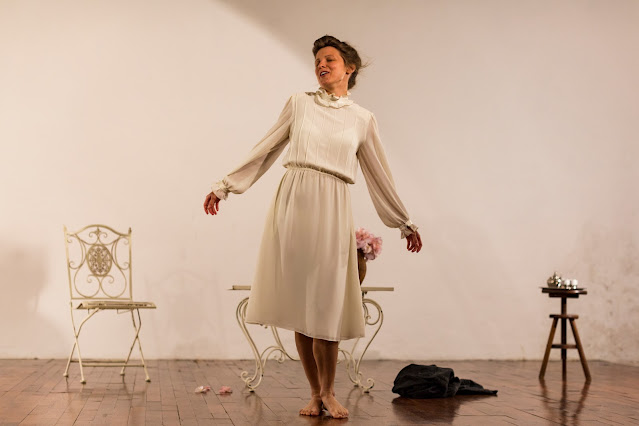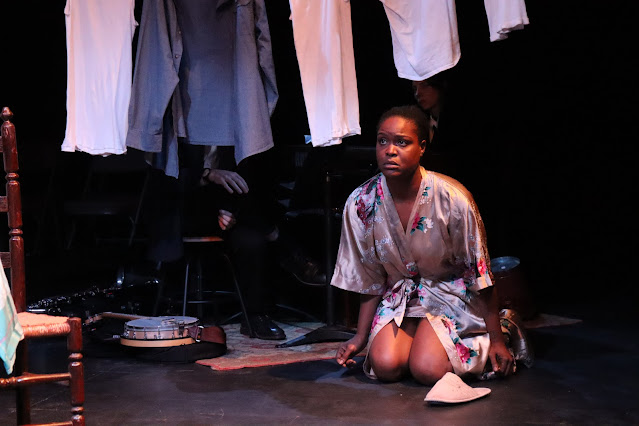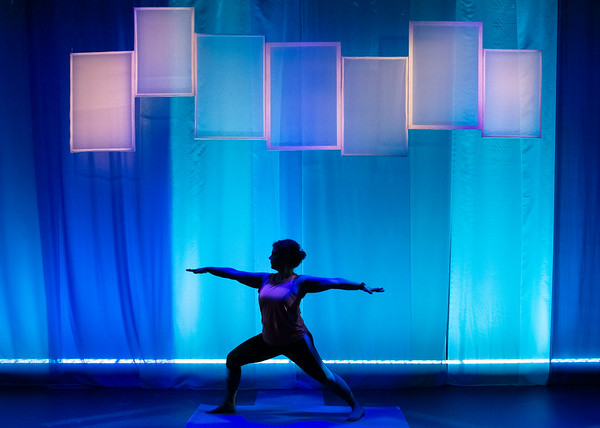Interview: Agnieszka Kazimierska Discusses Her Show "Katie's Tales," to Play NYC's United Solo Festival Nov. 11
 |
| Agnieszka Kazimierska in Katie's Tales. Photo by Renato Esposito. |
 |
| Agnieszka Kazimierska in Katie's Tales. Photo by Renato Esposito. |
Agnieszka Kazimierska: In a way - from the beginning. From the beginning I was looking for a female figure that can give body and voice to my own individual desires and aspirations, and at the same time to speak for many, to incarnate some mythical calling and experiences that are alive and crucial for the people collectively.
Initially, the character of Katie did not have a name. Initially she had certain qualities and aspirations. She had certain life experiences - shared with many other women. There was this childlike, playful, inventive, delicate, ephemeral beauty about her. And she - the still nameless woman - was deeply marked by the wisdom of cherishing humanity. She was loving the humanity hidden in the depths of people’s hearts. Her unrelenting love towards her Beloved, who comes in one form and in many forms at the same time, was to be her biggest strength and greatest challenge.
This initially nameless female character, whose quality lived in the beckoning of morning light, in the delicacy and ephemeral majesty of a blossoming cherry - that uncatchable yet evident beauty - was also somehow to be linked to Poland: to Polish earth, ground, tradition, language and history.
Several aspects of Her story were woven into Polish folk songs. And those songs were to be present in the piece. That I knew from the beginning. The songs were to be part of the narration and storytelling. They were to become an important part of performance’s territory that speaks not only through words, but through melodies that touch and resonate with memories, experiences, associations and echo them out into the world.
Prof. Kosiński said also: “Katy’s life experiences are encapsulated in songs.” And those resonances are living traces of her experiences - of one woman and of many.
Those songs came from Polish lands and have survived gracefully over the generations. They carried hope and longing. They survived as a force flowing forward thanks to the living participation of many women. Those women carried the stories and their melodies and handed them over to their daughters, and their daughters’ daughters.
When the storyline of the performance started to emerge, my interest in Katie as a historical figure grew. She became an embodied voice of my great-grandmothers and their kin, and their mothers and grandmothers, and their kin also. Katie became a voice for all those women who for long periods lived sustaining love, and hope, who were in the waiting, who learned to embrace separation and came to terms with the possible death of their husband, lover, or son, striving to make him alive and present in other ways.
Katie is a voice of generations: of those who survived and of those who did not, and their voices and experiences were absorbed down into the dark earth and into the dark ground of the human psyche as well. Those voices that wake up from time to time and want to speak. And we are very used to shutting them down. No one wants to grieve anymore. There is no space for loss, for grief, and thus - for the emergent praise that comes as grief’s companion.
There is a beautiful book by Martin Pretchel where he speaks about the interdependence and camaraderie of grief and praise. And how the experiences of Grief are a gateway to the reconnection with Praise: with that awe face to the mystery of life and death. He explains how we have lost those spaces.
In a way Katie is one of those mythical characters who is deeply loving and who is not afraid of grief and facing loss. She trusts love so much that no turbulence is going to stop her in her search for authenticity and deep connection to what’s most Cherished in life. And that’s also why a cherry tree is her companion. A wise tree, delicate but deeply rooted - Witness of the flow of life and death over human lifetimes.
In this sense, she is very very brave, I think.
 |
| Agnieszka Kazimierska in Katie's Tales. Photo by Renato Esposito. |
Agnieszka: Yes. We can say that “Tales” relates to the multiplicity of stories, to the several layers of meaning in the piece, to several languages of narration, and to the figure of Katie who speaks for one and for many at the same time.
The artistic languages you named with which I “speak” in the piece reflect the themes, layers of human existence, and non-evident temporalities that I aim to depict. And perhaps not only depict but rather which I seek to create an experience of.
Katie’s story includes her journey of waiting and becoming, her life’s events, her dreams, memories, desires interwoven with fears, and missteps. When I was trying to tell the multilayered story of Katie in a non-linear style of narration, a certain plurality of languages seemed to be appropriate.
There are: the realm of memory, the realm of and fantasy, the realm of dream and aspiration, the realm of historical events - whether in a personal story of the character or in the greater History common to people of the lands that Katie inhabits. Those different realms are related and interwoven. And the interweaving requires the presence of different kinds of threads.
At the same time I simply liked this way of weaving and playing with narration that is not obvious, but a bit hermetic, that is a puzzle to unfold, a form to grapple with.
“Katie’s Tales” are also an exploration of the human mind, or even more broadly - our psyche. And I think that when we start tracing the way that our psyche functions, we can see clearly that aspects of life come and go from the front stages of our attention. We constantly jump back and forth, we merge from one role into another, we change the logic and values depending on the changing circumstances. Consciously or not.
The way the garden of our psyche functions is not linear, not temporal… It does not follow one language or logic, but rather molds, unfolds, weaves a malleable narrative of what is happening. Yet our life is not only a narrative. There are also pools of experiences to which we come back, into which we anchor, and which further shape us: both our experiences and narratives. And each of those pools seems to have a different quality, and to respond to a different call, a different language.
In the piece there are moments of quotidian life, but there are also moments where the character seems to speak as if from another layer of our human psyche. And those other layers have - in my experience - different languages. Poetry and sound, songs seem to be more apt mediums to try to speak from and about those layers.
In other words, I think that this multiplicity of languages and layers of the performance is related also to the quality of our human experience. We live our experiences, daily, on multiple layers of being. Some of them are very literal, what Arnold Mindell names as Consensus Reality. And others are related to a more mythical, archetypal layer of our experience - the one that connects us both to the quality of the here and now, but also to experiences rooted in the past, or perhaps even rooted in some atemporal space of universal human experience.
 |
| Agnieszka Kazimierska in Katie's Tales. Photo by Nikita Chuntomov |
Agnieszka: What I’ve noticed is that many times people relate to the piece from inside their own cultural and historical contexts. They recognize some parallel personal or collective experiences in the cities and countries that they live in that resonate with Katie’s experiences and her tales.
What I have noticed is that the piece anchors certain themes and human experiences that are universal: love, desire for sanity, goodness, beauty, desire for meeting life and people at the level of generous humanity, a true one - one that embraces lights and shadows of who we are.
When I performed it for Slavic audiences there was a specific sensation of a meeting with the collective Slavic sensitivity, with the collective Slavic Soul, one can say. It might be because of our shared history resonating in our bodies. It might be because of a familiar sonority of our languages and their melodies. Or for some other reasons.
The witnessing of English-speaking audiences is different than for non-English speakers who are following the subtitles. Even though many non-English speaking people did tell me that it did not matter to them to follow all the text: they followed Katie and all the other characters of the Garden, and their experiences.
For me, what is very important is not only the language, but the spectator’s necessity vs lack of necessity of following a linear narrative. The piece is constructed in an almost dreamlike way, and some people enjoy it, and others don’t.
I noticed that everywhere, no matter the country, there are people who simply lean onto the piece and follow the performance as it is, like a dream, like a life unfolding in front of their eyes, and there are some people who want to understand more on the literal level.
To those who know themselves as wanting to understand everything, I want to say: Sit back and relax. You will probably not understand everything, but you will eventually get there.
There is also the readiness of the audience to feel that changes from context to context, from presentation to presentation. This readiness is like an eagerness to open up to what is in the feeling space amongst us. Sometimes the audience members are more ready, and at other times less. Also myself… sometimes I can open up with all that is there, and sometimes can’t. And that changes the lived experience of the piece. Not its story. But the quality of lived experience.
 |
| Agnieszka Kazimierska in Katie's Tales. Photo by Nikita Chuntomov |
We’ve done quite a bit of work on clarifying the context of the character, and new scenes and new characters were introduced. We have also done some changes to the style of the language. Initially there were several passages of old poetry from Christian and Sufi traditions. In order to make the piece a bit less cryptic and more accessible, I have rewritten some of those passages. We have also removed several poems. Something that initially could sound as a religious language was transformed into a language of love. It made things more simple, direct, and universal.
Initially the Beloved had direct religious connotations. And with the time and adjustment He became more mundane, and perhaps more universal at the same time.
So, yes, in the initial period Katie’s Tales kept changing and evolving. And from a certain point on - no not much anymore. Once the structure was defined, the main challenge was around the question: how to keep the piece alive? And answering that question practically requires small changes and adjustments from inside the set structure.
So these days the piece keeps evolving inside the structure. The more time I spend with those characters of the piece, the more nuances I start to know about them and about their lives, their superpowers and weaknesses.
In the recent years I have been introducing slight changes in the lines of actions of the characters, small small details in the ways they relate to each other.
But in general - there haven’t been many changes. And, except for adding subtitles - I was not trying to adapt the piece to any new cultural and historical context.
I was (and still am) curious what the piece that is set in the Eastern European context tells to audiences in different parts of the world. What do they make of it?
Within its own structure the performance has a capacity to dialogue with the unfolding History of our times. This is perhaps another thing that changes: the meaning of the piece in the changing historical and political context.
 |
| Agnieszka Kazimierska in Katie's Tales. Photo by Nikita Chuntomov |
Agnieszka: I think that for a Western viewer there will definitely be two strong allusions coming up: that of a mythical Garden of Eden, and the cherry orchard in Chekhov’s play. And those, in turn, can bring a number of literary and philosophical references, as the appearance of gardens as shelters, as mirrors of intra-human and inter-human relationships, has been deployed in literature and art for centuries.
In Katie’s Tales the Garden is a metaphor for our psyche, and tending the garden - for our spiritual road, that can potentially lead to a transformation. This Garden is filled with memories, hopes, desires, needs that wake up, one at a time, or sometimes many at once. Through the work of growing and weeding, a mythical transformation is possible. In the piece “the wedding” relates to this mythical transformation of the human psyche into the Garden Of Eden, which is a place full of beauty and wisdom. It speaks of the return to the place of banishment, of the return to the state of union, re-union, to the way of being that is whole and wholesome. I think that the setting of the garden will call on those associations and those human dreams. Which are literary, poetic, archetypical. They have been depicted and referenced in literature, paintings, psychology, and philosophy by many. Perhaps the meaning of the garden changes for different authors. But I think that the reference itself is fairly evocative.
For Zygmunt Bauman, with whom the reader might be acquainted, and who uses the metaphor of the Garden in his practice of philosophy and ideas describing the ways our modern societies function, the garden and gardener’s role are viewed as places and agents of tyrannic work. He says: “Modern genocide, like modern culture in general, is a gardener's job."
In Katie’s Tales the setting of the garden and of the gardener are understood in different terms. Unlike for Bauman, in Katie’s Tales the gardener is a being of knowledge in becoming, aware of the tyrannical tendencies, eager to engage in rigor of attentiveness and self-examination, keeping oneself accountable for deeds and ideologies that are constantly on the rise… testing back and again against the ability to love, and defending the love for humanity. Whatever form it takes… Here, in Tales, the question is: What does it take to embark on the tiresome journey of inner transformation so that the psychic garden can become a treasured field of authentic inner deep democracy. And peace.
Another reference that will appear commonly is to Chekhov’s Cherry Orchard. Many people when they even hear or read about the cherry trees in the piece ask me if the piece was inspired by Chekhov’s play. It was not inspired by the play. However, some aspects of ambience and the circumstances are in common. In Western societies this is such a strongly positioned drama that it’s hard to avoid that association.
I think that what wakes up in the minds of people is also the image of the Japanese Cherry blossom, commonly known in the West.
Cherry trees in blossom are about rejuvenation, elegance, delicacy, gentleness, ephemeral beauty. Some say that Cherry blossoms - Sakura - symbolize both birth and death, beauty and violence. They are a central motif in the Japanese worship of nature. I have recently discovered that they have also historically signified the short but colorful life of the samurai. Another reference that I did not know about until recently is that Sakura emblems adorned the planes of kamikaze pilots during World War II. Which is the historical setting of the Katie’s Tales piece.
________________________________
We at Thinking Theater NYC thank Agnieszka for taking the time to offer her fascinating perspectives on the questions which we posed to her. They have certainly increased our expectancy for the upcoming performance of Katie's Tales. You can see Katie's Tales as part of the United Solo Festival on November 11, 2023, at Theatre Row (410 West 42nd Street). The performance will take place at 7:00pm, with a running time of 55 minutes, and tickets are available here.



Comments
Post a Comment